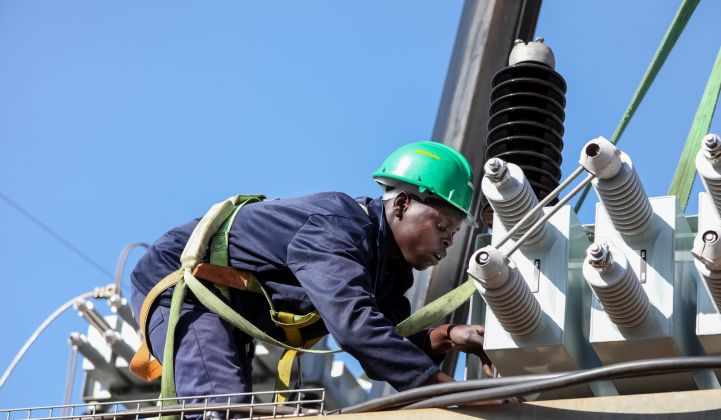Sub-Saharan Africa offers an alternative vision of how the energy transition will change power generation, according to research released today by global energy consultancy Wood Mackenzie, a Verisk business (Nasdaq: VRSK).
Benjamin Attia, a principal analyst with Wood Mackenzie’s Energy Transition Practice, said: “The evolution of sub-Saharan Africa’s utility business model, both on and off the grid, will fundamentally reshape the trajectory of global electricity demand and will be essential to the energy transition.
“Decentralised, bottom-up, solar-and-storage grids could not only transform sub-Saharan Africa’s energy future but carry important lessons for the next generation of thinking on utility business models globally. The future of energy may be forged there.”
He added: “These trends also present an opportunity to earn healthy returns by addressing one of the energy transition’s largest challenges as it unfolds over the coming decades.”
Sub-Saharan Africa has a persistent lack of electricity access, in part due to massive underinvestment in electricity infrastructure. Most of Africa’s public electric utilities are loss-making, with limited ability to maintain existing assets or invest in new ones. This hampers top-down growth in power supply and improvements in the availability, reliability, and affordability of power, Attia said.
But the rapid decline in the costs of renewable energy, coupled with innovative business models, could help sub-Saharan Africa bridge the gap between consumption and investment to provide universal, reliable, affordable and decarbonised access to electricity across the region.
Three fundamental macroeconomic trends underpin future electricity demand growth in sub-Saharan Africa: population growth, rapid urbanisation and structural economic transformation. This will contribute to strong growth in the region’s electricity demand. The region’s electricity demand has doubled over the last 15 years, and under Wood Mackenzie’s 1.5 °C Accelerated Energy Transition scenario (AET-1.5), could grow nearly eight-fold by 2050.
Wood Mackenzie said it would cost an estimated US$350 billion to electrify the region by 2030. The investment initiatives being pursued day to electrify the region hold important lessons for the global power industry as it meets net zero targets.
Attia said: “These investment opportunities work around the fiscal and operational bottlenecks posed by some of sub-Saharan Africa’s state utilities. Service providers are going straight to the bankable segments of residential, commercial, and industrial electricity demand, typically through distributed, renewable, off-grid solutions where the public utility does not feature.”
Opportunities are emerging beyond the grid for three customer segments, including residential, commercial, and industrial, and will collectively account for US$62 billion of the total African electricity investment opportunity this decade, according to Wood Mackenzie’s analysis.
“These opportunities go beyond basic access and bill savings, representing the early stages of a dramatic, fundamental evolution in the utility business model towards broader, customer-centric service provision,” Attia said.
Today, approximately half of African businesses rely on back-up diesel generators if the grid goes out, despite high and unpredictable costs. Wood Mackenzie conservatively estimates that more than 100 GW of distributed diesel capacity is operational across Africa today, and our findings suggest that at least 17 African countries have more distributed diesel generator capacity than they do grid-connected power-generation capacity. Across Sub-Saharan Africa (excluding South Africa), consumers spend just under US$20 billion a year on fuel for back-up generators, around 80% of what they spend on grid electricity. Even so, generators provide only 7% of total electricity supply.
Attia said: “For advanced electricity sectors, the energy transition is triggering a shift from traditional business models of generating, transmitting and distributing electricity to consumers towards an increase in customer-owned, behind-the-meter generation, battery storage, electric vehicles and demand response, in which both customers and utilities bring value to each other.”
This evolution has not begun in most under-electrified economies. But the vacuum left by public utility bottlenecks and far-from-universal electrification is being occupied by private firms with a new vision and a new way of generating and delivering power.
Distributed energy service companies are using a flexible prepaid service model to take advantage of the increasing affordability of solar and battery technologies in order to align cost, value and energy delivery. They can also manage credit risk directly and digitally outside the bounds of traditional utility cost-recovery mechanisms.
Off-grid electricity service provision is becoming an enabling mechanism for a host of other goods and services that customers are willing to pay for, most of which require basic electricity service.
This growth in market activity beyond the grid will begin to have an impact on future on-grid electricity demand.
Attia said: “Where centralised utilities and off-grid service providers clash, quality and cost of service will determine where consumer spending flows, especially for commercial and industrial users who suffer major productivity losses from interrupted service.”
As more high-value customers favour cheaper, cleaner, more reliable captive solutions, cash-strapped utilities are likely to see reduced revenues without equivalent reductions in cost, so will face more difficulties in maintaining and expanding their networks.
Where the national grid is almost non-existent, like the Democratic Republic of the Congo, the building of a bottom-up, distributed grid (rather than an existing centralised grid) could fundamentally change the role of the distribution utility in Sub-Saharan Africa, where customers can benefit from interconnecting and trading with nearby sources of generation and load, instead of operating on a fully captive basis.
Read Also

